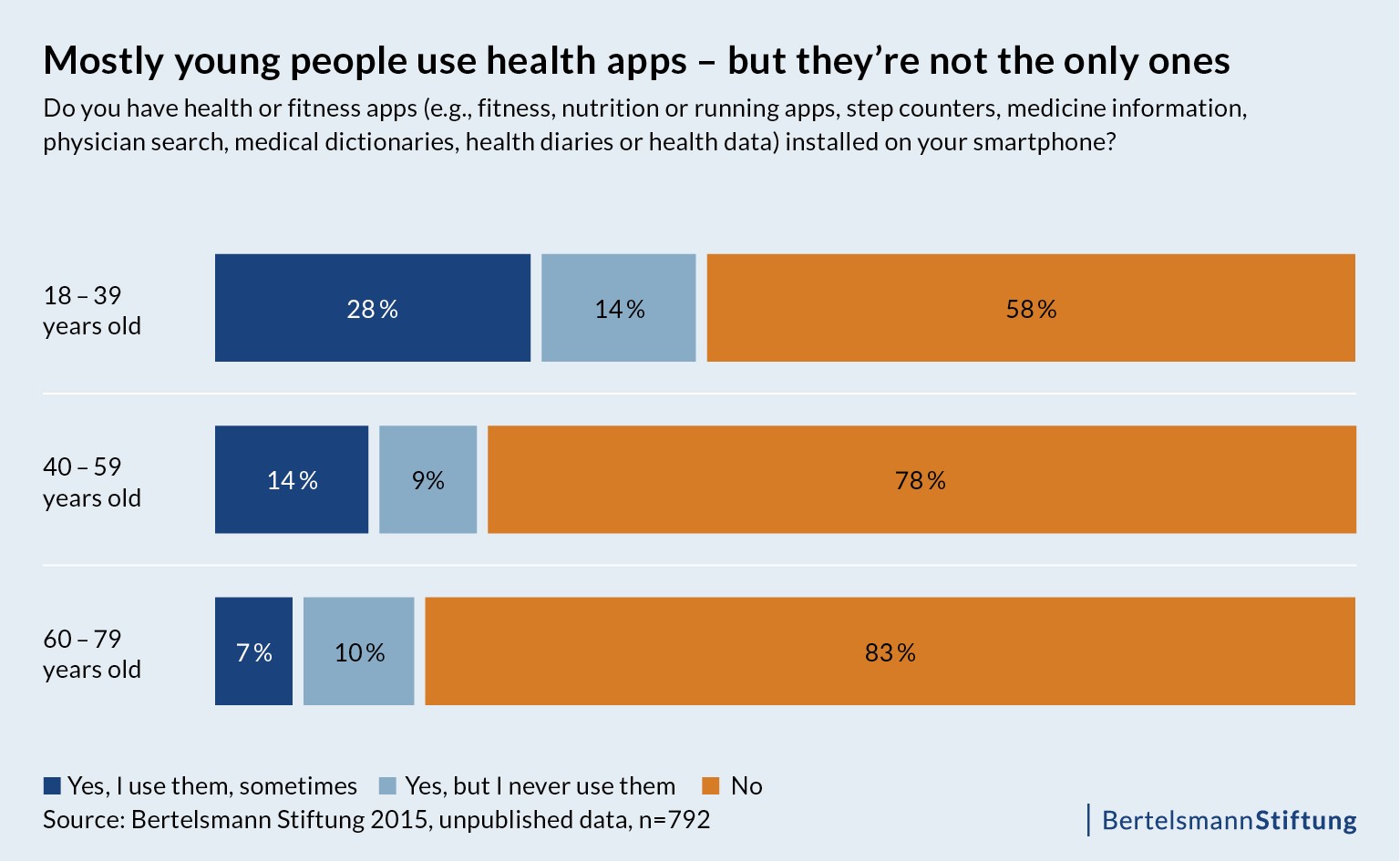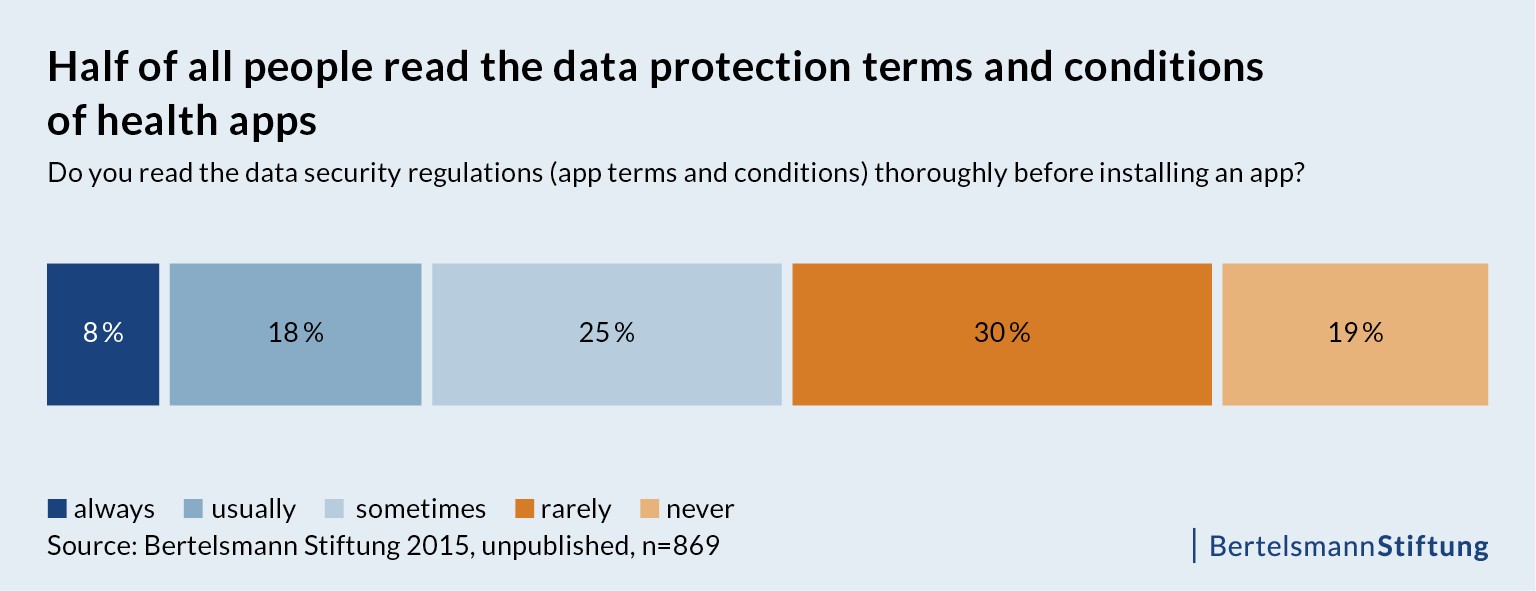To what extent are health apps relevant today? Who uses them? What potential do they bear and what challenges do they face? At the moment, we are exploring the trends underway in digital health apps at a number of events, for example at this week’s AOK-Tag 2016 (AOK Day 2016). For this event, we took another look at the data contained in the Bertelsmann Stiftung’s Gesundheitsmonitor survey and analyzed those findings that provided information on people’s use of health apps. The data – which were collected in summer 2015 – show that 29% of Germans already have a health app installed on their smartphones. More than one in three people indicated they would use this app for the purpose of self-management if they fell ill. One in five people indicated they would welcome the idea of having their own health data – drawn from the information already held at real-life doctors’ offices – on their smartphones. Nevertheless, data security and data protection are also considerable issues on citizens’ minds.
Digital technologies are changing our behavior when it comes to health and medicine. In addition to influencing the doctor-patient relationship – which we recently explored in our blog –, digital solutions also bear the potential to empower individuals in their role as patients. The hope is that patients will become more active and behave more autonomously in the future. A key tool in this development will no doubt be the smartphones in their hands. Whether as a digital aid reminding them to take their medication or as a provider of information before their next visit to the doctor, these new technologies make it possible for patients to take part in their own health management in an active and autonomous way. Today, more than 100,000 so-called health apps are vying for patients’ favor. Some estimates put the number of health apps available in app stores even higher, depending on how they are counted. Either way, demand for these apps is thus growing dynamically in line with the increasing number of apps available.
Number of health apps installed on smartphones experiencing dynamic growth
This development is also confirmed by the data contained in the Gesundheitsmonitor. Last year, we surveyed Germans on the issue of “health apps.” Our findings showed that 29% already have a health app installed on their smartphones. As recently as 2014, that figure was only 10%. In other words, the percentage increased by 19 points within only one year – a dynamic development that represents a tripling of app usage. One factor that should be taken into account when looking at these numbers is that many manufacturers already preinstall applications on their devices, for example Apple’s so-called “HealthKit.” Still, there is no denying the emerging trend: people are increasingly accepting health apps into their lives. As our survey data show, these are primarily training and fitness apps – the classic pedometer, as it were. One also sees the occasional nutrition app – calorie counters and info apps covering health issues – on people’s devices. However, apps with a more direct medical connection are still clearly underrepresented, which confirms the analysis of market offerings we undertook last year.
Growth especially evident among young people – but not limited to them
It comes as no surprise that the growth trend is particularly evident among young people. Already 42% of people in the 18-39 age group have health apps installed on their smartphones. But even in the older age groups, it would not be wise to underestimate the trend; a robust 17% of over 60-year-olds have and/or use a health app.
App use depends on level of formal education and social Status
Age is not the only factor determining the rate of health app usage. Our survey data show that the higher a person’s level of formal education and social status, the more frequently they will use health apps. While usage rates among people with basic secondary level education (Haupt- und Volksschulabschluss) were at 18%, 38% of citizens with a high level of formal education (university entrance qualification and/or university degree) reported having installed or used health apps on their smartphones. A similar distribution is found when we look at socioeconomic status. In other words, health apps do not yet lead to a visible increase in opportunities for participation, even though from a public health perspective they seem to offer precisely this kind of fostering of a broad level of participation via digital media. By contrast, no difference was found when comparing app use by chronic versus non-chronic sufferers. Here, too, the data confirms that the market does not yet appear to be (primarily) geared to epidemiological needs. Indeed, especially in self-management of the chronically ill, one would expect that apps could really develop their potential.
One-third of citizens would store self-measured health data on their smartphones
The survey data also show that more than one in every three people surveyed (36%) can already imagine storing their self-measured data – such as blood pressure and blood sugar – on their smartphones or tablets. In addition, one in five respondents indicated that they would be interested in having their own medical data – the information stored by real-life doctors on such issues as prior illnesses, allergies to medication and blood type – permanently available to them on their smartphones. An additional 23% of those surveyed stated that they might be interested in this. It is once again safe to assume that a person’s fundamental affinity to digital technologies plays a role here; that is to say that people who are already accustomed to being active online in other areas of their lives and who are generally more open to it will also see similar benefits in the health sector and be interested in benefitting from these advantages.
People see data security and data protection as relevant issues
While people are indeed interested in having access to their own data, they are also sensitive to issues relating to data security and data protection. Trust in data security on smartphones appears to be rather low. Only 18% believe that storing data on smartphones is (fairly) secure. Also, 82% of people assume that commercial companies might have an interest in their health data, and 83% of people believe that health insurance companies might also have an interest in this data. Yet another interesting aspect comes into play in the debate on health-related bonuses, where we see people’s willingness to give health insurance companies access to their health data rise as soon as financial bonuses are involved. Indeed, while 16% of people indicated that they would be willing to grant access to their health data, that number rose to 26% when financial bonuses were involved.
Survey participants showed a fundamental awareness of the issue of data protection in their response to a question on app-related data security regulations. Contrary to popular belief, as many as 26% of respondents indicated that they always or usually read the terms and conditions in full before installing an app, with an additional 25% saying they do this sometimes. These numbers surprised us, too. Overall, the survey showed that people consider it important to maintain control over their own health data – a conclusion we also came to in our study on electronic health cards. This is an issue that needs to be developed further so as to foster trust in apps and fully exhaust their potential via basic information and awareness training, but also by means of a transparent and understandable explanation of the data flows and procedures designed to ensure data protection and data security in each respective app.
What else needs to be done to ensure that health apps actually empower people in their role as patients? The data drawn from the Gesundheitsmonitor point to individual tasks, such as increasing opportunities for participation and focusing on the theme of data sovereignty. Today, people are faced with a growing range of digital technologies, and many of them are already using these in parts. However, what remains unclear is where exactly the chaff separates from the wheat. The healthcare system has not yet found a way to systematically handle these new applications. We are currently working on developing solutions designed to identify health apps that possess true potential for health care, and then how to more rapidly make it possible to use them in health care. In principle, the goal must be to exploit the potential of health apps in an even more systematic way.
Here now the PowerPoint presentation we gave on this issue at the AOK-Tag:
This powerpoint presentation is available in German only.
These data were collected as part of the Gesundheitsmonitor 2016. The survey participants comprised 1,598 men and women between the ages of 18 and 79 years old and the survey period lasted from June to July 2015. The findings of the survey are representative according to gender, age and region. The survey took into account only those answers given by people who indicated that they owned a smartphone; this group made up a total of 56% of the people surveyed. For more information on the Gesundheitsmonitor, visit gesundheitsmonitor.de
Click here to subscribe to our newsletter:




